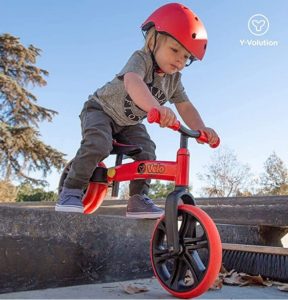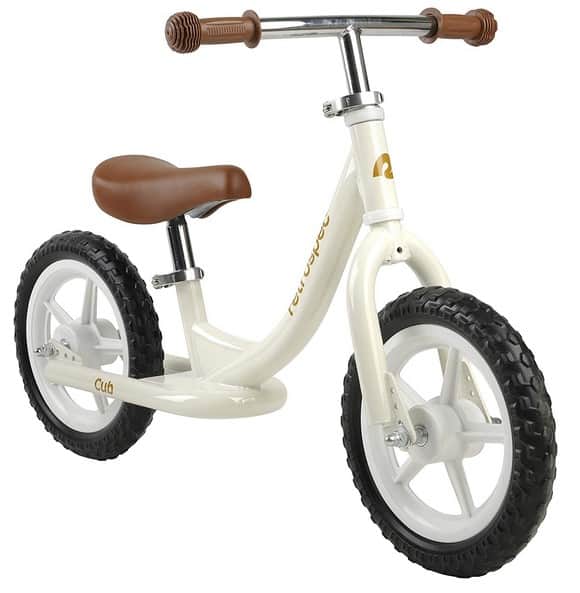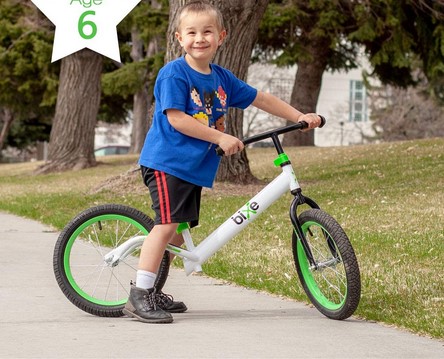As a young parent, I cannot imagine a more intimidating experience than teaching a 2-year old how to balance a pedal bike. Luckily, we now have balance bikes that promise a much easier learning process. But is a balance bike worth it?
Balance bikes are designed to teach children to balance, coast, and steer a bike without pedaling. Such motor skills build their cycling confidence and make the transition to pedal bikes easier.
As you’ll learn, balance bikes are safer and funnier to ride, even on uneven surfaces, and they are available for all kids’ age groups.
You probably are asking, ‘what about regular kids’ bikes with training wheels (stabilizers)?
Well, I’ll help you understand why balance bikes are more favorable for kids who are yet to learn to balance on a two-wheel.

But before that, what is a balance bike?
Balance bikes (also known as pedal-less bikes, runner bikes, or glider bikes) are bicycles designed to teach kids, especially younger ones, to balance on a bike.
By doing so, kids also learn to coast (roll-freely without pedaling) and steer the bike more confidently. Such skills are essential before kids can learn to pedal.
Note that balance bikes don’t have pedals, drivetrains, gears, shifters, chains, or freewheels.
In a rush? Find (below) the best balance bikes for kids of different age groups.
3 Best Balance Bikes for Kids
- XJD Baby Balance Bike – Best for 1-2-Year-Olds
- Strider -12 Sport Balance Bike – Best for 2-5-Year-Olds
- Bixe 16″ Pro Balance Bike – Best for 5-9-Year-Olds
Is A Balance Bike Worth It? 6 Reasons to Get One
Here are the reasons why getting a balance bicycle for your kid makes sense:
1. Balance Bikes Improve Kids’ Motor Skills
The first step for learning to cycle is balancing, and the second step is to coast (freely roll without pedaling. Last but not least, the young one should master how to turn and steer the bike.
All those are achievable with a runner bike. Your kid’s motor skills for balancing, coasting, and turning develop considerably.
2. Balance Bikes Are Safer on Uneven Surfaces
When compared to regular kids’ bikes and tricycles, balance bikes are much safer. Tricycles and kids’ bikes with training wheels are difficult to maneuver on uneven grounds, and your kids could easily fall off.
That, however, is not the case with runner bikes. Kids concentrate more on balancing than pedaling when riding balance bicycles.
Thus, they are more prepared for bumpy patches. They won’t fall easily to hurt themselves.
3. Balance Bikes Improve Cycling Confidence
Balance bikes allow kids to learn to cycle independently. It becomes easier for them to do it without your help, and that builds their cycling confidence.
Kids find runner bikes easier to get on and off. They also can turn and coast with confidence.
An option like the Retrospec Cub Kids Balance Bike (View on Amazon) cultivates confidence by encouraging intuitive balance, coordination, and coasting.

4. Balance Bikes Are Funnier To Ride
The fact that balance bikes teach your kid to balance, coast, and turn quicker makes them more accessible and funnier to ride.
I remember my boy getting frustrated trying to balance on his bike even though it had stabilizers. But once I got him a runner bike, he became happier and started to enjoy riding.
5. Balance Bikes Make Transitions to Pedal Bikes Easier
Ask an experienced cyclist about the secret to learning to bike, and they’ll tell it to first master to balance.
Once you know how to balance, it becomes easier to coast, and eventually, you get the confidence to pedal seamlessly.
A balance bicycle helps your kids learn to balance, coast, and turn much quicker and safer. Consequently, it becomes easier to ride a regular pedal bicycle.
6. Balance Bikes Are Available for Kids of All Ages
Ordinarily, regular kids’ bikes with training wheels come with wheels that are at least 12 inches. Even though manufacturers argue that such bikes suit kids from age 2, very few 2-year-old can fit on them.
Again, what about kids who are younger than two years?
Well, that’s where runner bikes come in. There are runner bikes for 1-year-olds to 9-year-olds.
Here are a few examples of balance bicycles for the various age groups.
- XJD Baby Balance Bike – Best for 1-2-Year-Olds
- Strider -12 Sport Balance Bike – Best for 2-5-Year-Olds
- Bixe 16″ Pro Balance Bike – Best for 5-9-Year-Olds
Is A Balance Bike Worth It More Than Training Wheels? (Balance Bike vs. Training Wheels)
Here’s a comparison of balance bikes with regular kids’ bikes with training wheels.
a) User Suitability
Regular kid’s bikes come from size 12-inch (referring to their wheel size), which doesn’t favor kids younger than three years.
12-inch bikes, even with training wheels, have a slightly higher seat height, making them unsuitable for younger kids.
Balance bikes, in contrast, have a low seat height that makes them suitable for kids who are as young as 18 months.
A runner bike like the Schwinn Balance Toddler Bike (View on Amazon) might be having 12-inch wheels like regular kids’ wheeled bikes but enjoys a much lower seat height.
As a result, it suits kids who are 2-4 years.

b) Balance and Maneuverability
Balance bikes are called so for a reason. They teach kids to balance on a bike confidently.
Training wheels, however, hold them back from balancing independently. The kids become too dependent on the wheels to offer them extra stability.
And when it comes to maneuvering a bike, kids find balance bikes more maneuverable. Since these bikes are closer to the ground and moving at a much slower pace, kids quickly turn and steer them.
That’s often not the case with wheeled bikes, as they are often heavier and slightly higher off the ground.
c) Riding on Uneven Surface
Training wheels wobble when going over a rough patch. The stabilizers easily get caught with grass, small stones, and other obstacles outdoors, making them unsuitable for uneven surfaces.
Runner bikes, in contrast, roll over obstacles, making them the better option for uneven grounds.
d) Bike Weight
Bikes with stabilizers usually are heavier than balance bikes. So, kids, especially younger ones, find them hard to move around and pedal.
While most bikes with training wheels weigh about 15 pounds, most balance bicycles weigh half the weight or less. As a result, kids find them easier to carry over short distances.
A glider bike like the Strider -12 Sport Balance Bike only weighs 6.7 pounds but can comfortably bear a 2-5-year-old weight.
e) Independent Riding
While your kid won’t fall off a bike with training wheels when it’s not in motion, it’s safer when you are there to help them ride.
Also, sometimes you have to wait until the kids are about three years old before they can ride independently. That, however, is not the case with balance bicycles.
Balance bikes allow kids to ride on their own as young as 18 months. They get to stand, balance, coast and get off independently.
f) Transition to Regular Pedal Bikes
Once a kid learns to balance, coast, and turn on a bike, they find pedaling much more straightforward. That’s precisely what balance bicycles guarantee.
While kids can also learn to balance, coast, and turn on regular wheeled bikes, it usually takes longer to master the skills.
Training wheels hold them back from trying to balance or steer the cycle on their own.

Is A Balance Bike Or Training Wheels Better? Summary
Now, here are the takeaways from the above comparison:
- Balance bikes are better suited to much younger kids
- Balance bikes are much safer and smoother on uneven surfaces
- Runner bikes (balance bikes) are lighter in weight and easier to ride
- Runner bikes teach your kids to ride independently
- Balance bikes make transitions to pedal bikes easier
- Balance bikes are more maneuverable
What Are the Disadvantages of a Balance Bike?
I’ve discussed the reasons why balance bicycles are worth it and their advantages over training wheels. But does that mean that these bikes are flawless?
Of course not; and here are their two primary concerns:
- Kids outgrow balance bikes faster – Since kids learn to balance, coast, and turn quickly on balance bicycles, they are likely to outgrow them quickly. So, you may find yourself shopping for a pedal bike in no time.
- Balance bikes can be expensive – Most high-quality runner bikes cost as much as (if not more than) regular kids pedal bikes. Given that kids outgrow them fast, this is something you’ve to consider carefully.
Best Balance Bikes Reviewed
1. XJD Baby Balance Bike (Best for 1-2-Year-Olds)
If you are looking for a runner bike for your adventurous toddler, nothing beats the XJD Baby Balance Bike. This glider bike is a perfect birthday gift for your one or 2-year-old.
It is lightweight (only 3.96 pounds), thus portable to allow you to carry it on travels. The balance bicycle is also comfortable thanks to its soft seat and non-slip EVA handle.
Plus, it has a sturdy carbon steel frame to stay steady, and its wheels are wide and enclosed to prevent the toddler from falling off.
This infant runner bike is easy to ride and safe, and its assembly is quick (taking 2-3 minutes) and tool-free.

Best Features
- Lightweight but sturdy frame
- Wide, enclosed wheels
- Tool-free set-up
- Non-slide EVA handle
- Soft seat
2. Strider -12 Sport Balance Bike (Best for 2-5-Year-Olds)
The Strider -12 Sport Balance Bike comes in a perfect design for kids who cannot balance or steer a pedal bike.
The bike only weighs 6.7 pounds but can hold up to 60 pounds.
Its handlebar and seat are pretty adjustable to fit kids aged 2-5 years perfectly. Mark you; you don’t need tools to adjust it.
Thanks to its mini-grips, your little one can comfortably maneuver the bike around.
Moreover, its steel frame promises lasting use, while its 12-inch wheels feature puncture-proof tires with zero maintenance.
Overall, this runner bike has a built-in footrest and an ergonomic padded seat to improve your kid’s comfort.
Best Features
- 60-pound capacity
- Steel frame
- Puncture-proof tires
- No tool adjustment
- 12-inch wheels
- Mini grips
- Ergonomic seat and footrest
3. Bixe 16″ Pro Balance Bike (Best for 5-9-Year-Olds)
Don’t worry if your kid is older than five years and cannot ride a bike. All it takes to inspire some confidence is the Bixe 16″ Pro Balance Bike.
This 16-inch runner bike suits 5-9-year-old kids and promises a faster and safer bike-learning experience.
Its wheels are equipped with reliable safety washers, while its frame is robustly built to tolerate kids who weigh up to 150 pounds.
Its clamps come tamper-proof. Plus, its wheels are firmly attached, and the bike is generally lightweight (11 pounds). And given that it comes partially assembled, this runner bike is easier to set up.
Everything about the design makes it also ideal for kids with special needs.

Best Features
- 150-lbs capacity
- 16-inch wheels
- Safety washers
- Tamper-proof clamps
- Simple set-up
- Secure wheels
FAQs
1. What Age Is A Balance Bike For?
Most kids’ balance bikes are designed for kids who are at least 18 months or two years to about five years. However, we now have balance bikes for older kids, such as Bixe 16″ Pro Balance Bike that suit 5-9-year-olds.
2. What’s The Point Of Balance Bikes?
The point of balance bikes is to make it easy for a kid to learn to balance, coast, and turn on a two-wheel. Once they do so, it becomes easier for them to ride a pedal bike.
3. Are Balance Bikes A Waste Of Money?
Balance bikes are not a waste of money. On the contrary, they teach kids how to balance, coast, and turn a bike. They make the transition to pedal bikes much more manageable and comfortable for kids.
Also Read:
Is A Balance Bike Worth It? Closing Thought
Balance bikes are an excellent choice for kids who are not confident enough to ride a pedal bike. These bikes teach the young ones to balance, coast, and turn – skills essential in riding a regular pedal bike.
So, if you want your kid to transition to a regular pedal bike easily, get them a balance bike today!
Frequently Asked Questions
Would Investing in a Balance Bike be Beneficial?
Absolutely! pouring resources into purchasing a balance bike can be a remarkably effective tool in child development. They are designed to refine and strengthen your child’s sense of equilibrium and motor coordination which will be paramount in their bike-riding journey. Quite obviously, learning to balance is the cornerstone of mastering the art of cycling, and a balance bike nudges your little munchkin a few steps closer to that task! I recall when I was teaching my little niece how to ride, and trust me, a balance bike was a total game changer! It boosted her confidence exponentially which indeed was heartening to watch.
What works better, a Balance Bike or a Bike without Pedals?
Well, you’d be surprised but either works perfectly fine! That’s right. A clever little workaround I discovered studying child behavioural psychology is to simply unbolt the pedals from your child’s bike, effectively converting it into a balance bike and you’re good to go! Scrimping on those few extra bucks, this hack allows kids to zero in on what’s really important – gaining their balance. Essentially, it’s all about learning to **BALANCE FIRST** and adding in the pedaling later, making the entire process of learning significantly simpler.
Do Balance Bikes actually contribute to Kids’ Learning?
Without a shadow of doubt, balance bikes prove to be incredibly beneficial in facilitating children’s learning. Balance bikes scrap the use of stabilisers allowing kids to get a grip of maintaining balance while moving- an essential skill in riding. The entire process fast-tracks the transition to a pedalled bike and it’s completely hassle-free. This somewhat mirrors my neighbour’s experience with her son. He mightily struggled with pedaling initially but after a few weeks on a balance bike, he gained considerable control and confidence. Thereafter, transitioning to a pedal bike was a breeze!
Is a Balance Bike apt for a 4-Year-Old?
Definitely! Kids develop at their own pace and it’s completely okay if a 4-year-old, or sometimes even older kids, exhibit a preference for balance bikes. The universality of balance bikes is what makes it suitable for a wide range of ages. Some enthusiastic tykes might move on to pedalling independently as early as 3 or 4, while others might take their sweet time. I’ve seen kids as old as 6 or 7 happily whizzing around in their balance bikes, perfectly content with the pace of their progress. So, in the grand scheme of things, what matters most is your child’s willingness and readiness to ride independently.